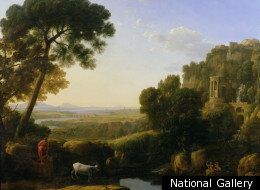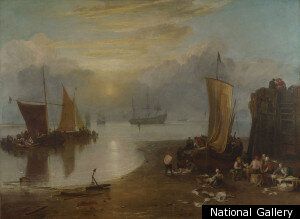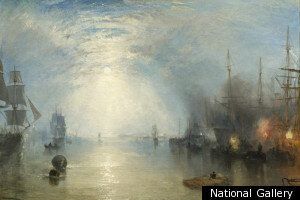For Talleyrand, the French diplomat who successfully navigated a career under the Bourbon Monarchy, Revolution and Napoleon, those who hadn't had the luxury of living in the serenity of pre-Revolutionary France had not tasted the 'sweetness of living'. It's an image of pacific order and calm; manicured lawns and symmetry. Nothing seems to sum up this idea better than the ethereal glow and peace of Claude Lorrain's landscapes.
Perfectly proportioned and lit by a radiant sun, Claude appeals both to the viewers natural aesthetic taste - balance, harmony and proportion - as well as their intellect. One can quite imagine the powdered and carefully pruned French dandies of the period nodding along in agreement at the serene images of his classical Arcadia. And, in self-congratulating triumph, a few would correctly identify the hints of classical learning sprinkled about the landscape. As ever with a good artist, Claude can be appreciated by both an intellectual snob and a five year old.

This exhibition highlights the inspiration that Turner took from Claude. Separated by nearly a century, Turner emulates Claude's use of light, careful framing of landscapes and attempts at touching on something more sublime than a simple rendition of reality. Take the examples of Claude's Embarkation of the Queen of Sheba from 1648 and Turner's Sun Rising through Vapour. The pair are remarkably similar in their effects and the sense of calm that they produce. Even with Turner's rendition of industrial Britain, a similar mood is produced. Keelmen Heaving in Coals by Night - which is one of the show's highlights - creates an odd sense of harmony amidst dancing flames, the glow of fires and silvery calm waters under a spectral moonlight.
Yet there are differences between the two men - and the differences soon become much more interesting than their obvious similarities. Claude's Queen of Sheeba depicts a reassuringly distant and inoffensively classical scene; Turner's Sun Rising peels back a murky squalor of fishermen squelching around on the sodden beach, seemingly fresh from some disagreement. One image comes from a time of absolutist monarchy where the State could often represent nothing more than the will of a monarch; the other is painted after a groundswell of popular consciousness in a Europe basking in the glowing light of Reason. Turner, therefore, is doing more here than simply sullying the sublime with a bit of Hogarthian coarse humour. Indeed the very sun which illuminates his image may represent something quite different entirely from Claude.

Similarly, take the example of Turner's early attempt at the Claude master piece Landscape with Narcissus and Echo. The stylistic similarities are easy to discern, but with Turner we are left with a rougher, coarser image. And while Claude's image seems to blankly smile at the viewer, tickling our sense of the sublime, it doesn't have the same brooding quality of Turner. Unlike Claude, Turner actively inhabits his paintings in an an often malevolent and disruptive way. He consciously lives out many of his works. We get none of the pained emotional isolation with Claude's Echo, for example, after she is rejected by Narcisssus. With Turner's Regulus, however, we are exposed to the same piercing agony as the subject.
Turner then is doing much more than simply marking the point at which factories and chimneys start to stud the Claudian landscape; he is doing much more than simply replacing one French classical Arcadia with another equally fictious mythical British past in images like Linlithgow Palace. Indeed, it should hardly come as a surprise that as the painter's whole soul became fused with the canvas, Turner eclipses Claude in this exhibition. Yet rather than pursuing what is hinted at, we are limited to stylistic similarities and superficial differences. None of Turner's radical images of apocalypse, plague and death are present here. As a result the exhibition's fault lies not so much in drawing similarities - familiar though they may be - but shying from the intellectual gulf that seperate Turner from Claude in favour of presenting the easier aesthetic similarities. Such issues, of course, are not easily described in exhibitions. Yet when missed we are left with a Turner who loses his vital significance.
